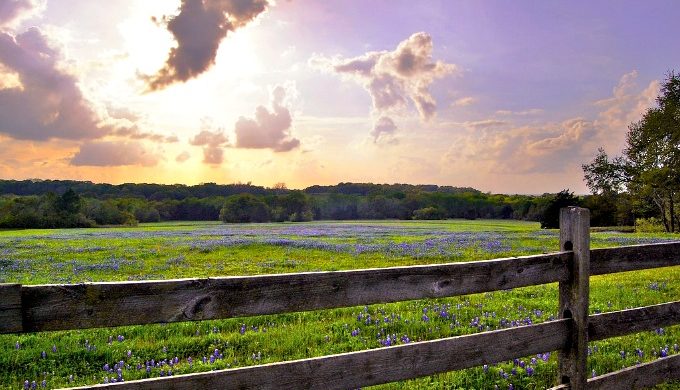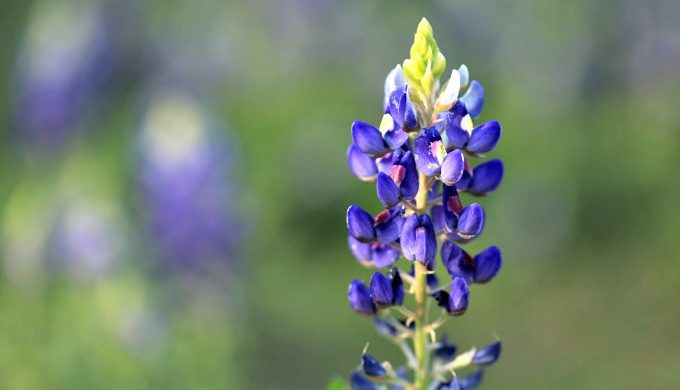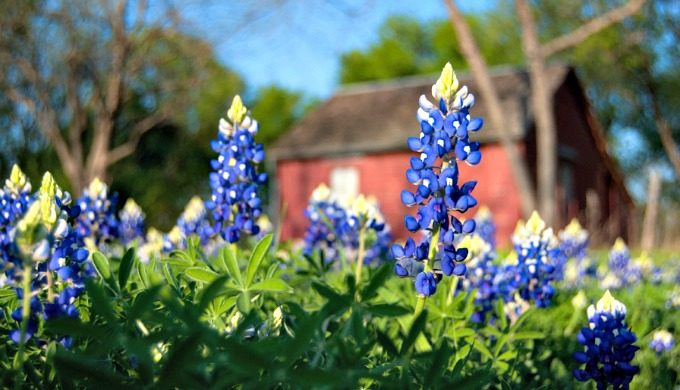Nothing is more of an icon of our state than the Texas bluebonnet, named for its resemblance to a woman’s sunbonnet often used to ward off the harsh Texas sunlight. Today, you will see children decked-out in their Easter Sunday finest and posed among a field of bluebonnets on any given spring day. No one can argue there was ever was a more-loved wildflower than the bluebonnet. However, few know the difference between fact and fiction when it comes to the history, legends, and myths of the bluebonnet, and how it manages to come back, year after year, to the delight of residents and visitors alike.
History
The Texas Bluebonnet: Its Legends and Myths
Legends of the Texas Bluebonnet

Photo: Flickr/MVX
One legend of the Texas bluebonnet is its very origins. It has been a long-held rumor that the flower came to Texas by way of Spanish explorers. Some say that the explorers obtained the seeds from priests in the Holy Land, sending the special flowers as a good luck charm for the new land. Some believe that these Spanish explorers used the seeds to bribe mischievous Native Americans into cooperating with explorers. While both stories are entertaining to consider, neither is true. The Sandyland Texas Bluebonnet is as native to Texas as Willie Nelson and Shiner Bock, and any bluebonnet-like flower that came from Europe would be different from what grows here today.
Another legend of the bluebonnet that takes a decidedly more mystical angle comes from the Jumano Indians. The Jumano Indians tell a tale of a time when missionaries were making their way through New Mexico and Texas, spreading the word of Christianity to the tribes. The Jumanos reported seeing multiple visions of a nun, dressed in a rich, cobalt-blue color. She visited them in their dreams and taught them about Christianity. On the morning after her last otherworldly visit to the tribe, they awoke to find the entire field where they were sleeping to be covered in a beautiful flower–the exact, deep blue color of the nun’s habit.
Yet another legend surrounding the state flower is that of the rarely seen pink bluebonnet. Legend has it that the pink bluebonnets are most often found “downstream” of the Alamo and represent the blood that was shed at the battle of the Alamo. According to legend, the pink bluebonnets are found near the San Antonio River and within sight of the historic mission where so many lives were lost in the battle for Texas’ independence from Mexico.
A Divisive Beginning as the State Flower

Photo: Flickr/SETShots
The first state flower of Texas was the Lupinus subcarnosus. This incarnation of the Texas bluebonnet is a tiny, unassuming version of the flower and most commonly found in coastal and south Texas. It won out as the Texas Legislature’s choice for state flower in 1901, when the legislature first set out to name a flower that best represented Texas. Among the runners-up for state flower in 1901 were the cotton boll and the cactus.
It was a hard fought battle for the title though, made possible largely due to the efforts of a tenacious group of women. The women, who made up the National Society of Colonial Dames of America in the State of Texas, couldn’t bear the thought of a cactus or a cotton boll representing their beloved state. So, they set to work, displaying paintings of bluebonnets on the floor of the legislature and even going so far as to make floral arrangements of bluebonnets to adorn each politician’s desk the day of the voting. After careful consideration, the striking beauty of the bluebonnet appealed to the legislature most.
Unfortunately, some people argued that, out of all of the varietals of bluebonnets, (yes, there are more than one type of bluebonnet!) the Lupinus subcarnosus is the least attractive and least ubiquitous of the bluebonnet varieties in Texas. They contended that the Lupinus texensis, the more pronounced, larger, and bolder version of the flower should represent the state instead. However, the Lupinus subcarnosus held the title of the state flower until 1971 when the legislature decided to settle this epic legislative battle by combining the two varieties of bluebonnet into one official, generic state flower. They added “any other variety of bluebonnet not heretofore recorded” to the decision, thereby covering all of their bases.
Myths of the Bluebonnet: Roadside Bluebonnets Are Naturally Occuring

Photo: Flickr/Jack
To debunk this myth, we turned to the Texas Department of Transportation, which was organized in 1917. Shortly after the organization was formed, officials noted that wildflowers were among the first plants to reappear along roadsides after road construction had been completed. This inspired the Texas Department of Transportation to capitalize on this hearty flora to beautify Texas’ highways and to aid in anti-erosion efforts. They enlisted the help of landscape architect, Jac Gubbels, who in 1932 encouraged and cultivated the growth of native wildflowers along Texas highways.
As a result of Gubbels work, to this day, the department delays the mowing of Texas roadsides until after wildflower season has come and gone to help encourage the growth and prosperity of future crops of Texas wildflowers along our highways. Every year, the Texas Department of Transportation purchases and sows roughly 30,000 pounds of wildflower seeds (much of which is comprised of bluebonnets) to create the fields of beauty that compliment our roadways.
Myth: Cold Weather Is Dangerous for Bluebonnets

Photo: Wikimedia
With Texas’ recent cold weather, many might be concerned about the forecast for the 2018 Texas wildflower season. Does the cold weather harm the plants? The short answer is no. In fact, the colder weather helps to build the root structure of the bluebonnet plant, which yields a stronger, studier plant that is capable of producing more showy, bold and larger blooms in spring.
Myth: It Is Illegal to Pick A Bluebonnet

Photo: Flickr/Jason Cargill
Contrary to what your mother probably told you, no, it is not illegal to pick a bluebonnet. What is illegal, though, is trespassing on private property in order to pick or view bluebonnets. It is also advisable to use caution when walking along highways and other roadways to admire the flowers. Many people get lost in the awe of a field filled with blue, red, and pink, and forget that they are merely steps away from speeding traffic.
No matter its origins or the myths surrounding it, the Texas bluebonnet remains one of the most beloved and recognizable symbols of our great state. Its determination to come back–year after year–stronger than ever, is symbolic of the people who call this great state their home. Bluebonnets are at their prime for only a small, two to four week window of time every spring, and they serve as a peaceful reminder that life is short. We should all take the time to stop and admire this bold, showy state flower of Texas while they are here.
Sources:
www.aggie-horticulture.tamu.edu
Originally published in Heart of Texas Magazine, Spring 2018, by Texas Media Group, LLC. All Rights Reserved.



